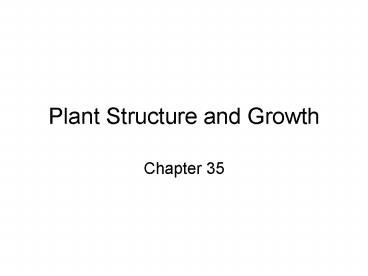Plant Structure and Growth - PowerPoint PPT Presentation
1 / 34
Title:
Plant Structure and Growth
Description:
Water-conducting elements of xylem ... 35.8 Water-conducting cells of xylem. Sieve-tube members, sieve plates, ... Xylem -- vascular. Phloem -- vascular ... – PowerPoint PPT presentation
Number of Views:275
Avg rating:3.0/5.0
Title: Plant Structure and Growth
1
Plant Structure and Growth
- Chapter 35
2
- Genes AND environment affect plant structure
3
Figure 35.1 A comparison of monocots and dicots
4
Figure 35.2 Morphology of a flowering plant an
overview
5
3 organs of plants
- Roots anchor plant, prevent erosion
- absorb minerals and water
- store food
- Stems transport system
- store food (tubers ex potato)
- support leaves
- protect tissues
- Leaves - photosynthesis
- funnel water to roots
6
Concept Map
Section 23-1
Plant Tissues
include
includes
includes
includes
includes
includes
7
Figure 35.4 Modified shoots Stolons, strawberry
(top left) rhizomes, iris (top right) tubers,
potato (bottom left) bulb, onion (bottom right)
8
Figure 35.5 Simple versus compound leaves
9
Figure 35.6 Modified leaves Tendrils, pea plant
(top left) spines, cacti (top right) succulent
(bottom left) brightly-colored leaves,
poinsettia (bottom right)
10
Figure 35.7 The three tissue systems
Vascular transport (xylem and phloem) Dermal
outer coverings, protection, water
conservation (epidermis, cuticle)
Ground filler, packing material for
cushioning Also Can photosynthesize, store
materials, and support plant
11
Tracheids and vessel elements water movement
- Water-conducting elements of xylem
- Elongated cells, dead at maturity (this leave a
hollow tube for transport) - PITS are thinner regions of secondary walls where
only primary walls are present
12
Figure 35.8 Water-conducting cells of xylem
13
Sieve-tube members, sieve plates, companion cells
-- food tranport
- Sieve-tube members chains of cells that form
tubes for transport of organic cmpds like sucrose - Sieve plates in angiosperms, have pores that
help move fluid from one section to another - Companion cells not involved in conduction, but
help other cells that dont have organelles of own
14
Figure 35.9 Food-conducting cells of the phloem
15
Plant tissues composed of 3 cell types
- 1. Parenchyma primary walls that are thin and
flexible, no secondary walls - (typical plant cells least specialized)
- perform metabolic functions photosynthesis,
starch storage (plastids), also make up fleshy
part of fruit - 2. Collenchyma thicker primary walls, unevenly
thickened stringy - no lignin present, so provide support without
restraining growth - living and flexible, can elongate
16
- 3. Sclerenchyma thick secondary walls with
lignin present (much more rigid) support!!! - cannot elongate, so found in regions where
plants have stopped growing
17
Figure 35.11 The three major categories of plant
cells
18
Figure 35.12 Locations of major meristems an
overview of plant growth
19
Meristems
- Regions of active cell division
- Apical meristems at tips or apex of roots and
buds of shoots - for PRIMARY GROWTH
- Lateral meristems cylinders of dividing cells
extending along length of roots and shoots - for SECONDARY GROWTH
20
Figure 35.13 Morphology of a winter twig
21
Figure 35.14 Primary growth of a root
22
Primary tissues of roots
- Epidermis -- dermal
- Cortex -- ground
- Stele -- vascular
- Endodermis -- ground
- Pericycle -- vascular
- Pith -- vascular
- Xylem -- vascular
- Phloem -- vascular
23
Figure 35.15 Organization of primary tissues in
young roots
24
Primary tissues of stems
- Epidermis -- dermal
- Cortex -- ground
- Vascular Bundle vascular
- sclerenchyma, phloem, xylem
- Pith -- ground
25
Figure 35.18 Organization of primary tissues in
young stems
26
Tissues of Leaves
- Cuticle
- Upper epidermis
- Palisade parenchyma
- Spongy parenchyma
- (contains veins xylem and phloem)
- Lower epidermis
- (contains guard cells)
- Cuticle
27
Function of Guard Cells
Section 23-4
Guard cells
Guard cells
Inner cell wall
Inner cell wall
Stoma
Stoma Open
Stoma Closed
28
Figure 35.19 Leaf anatomy
29
Figure 35.21 Secondary growth of a stem (Layer 3)
30
Figure 35.22 Anatomy of a three-year-old stem
31
Figure 35.23 Anatomy of a tree trunk
32
Figure 35.24 A summary of primary and secondary
growth in a woody stem
33
Figure 35.35 Organ identity genes and pattern
formation in flower development
34
Figure 35.36 The ABC hypothesis for the
functioning of organ identity genes in flower
development































